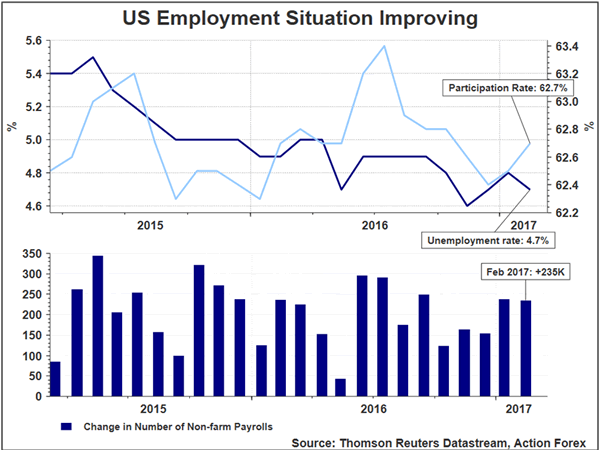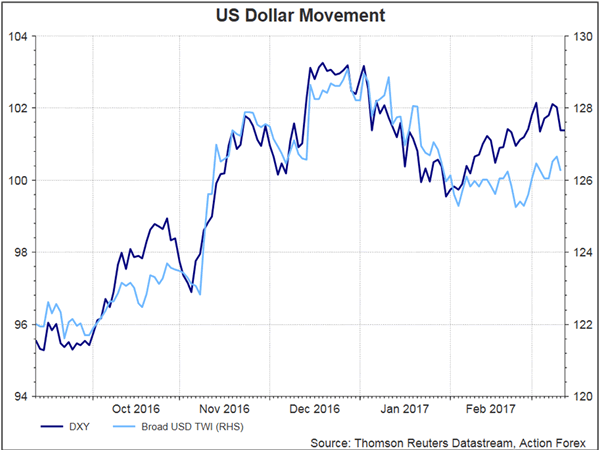FOMC is highly likely to raise its policy rate, by +25 bps, to a range to 0.75-1% in March. With a March rate hike a done-deal, the market focus turns to the future monetary policy stance. We expect two more hikes, one in June and one in September, this year. Given the recent improvements in employment and inflation, the market has begun talking about four rate hikes in 2018. For now, we stick to three, as suggested in December’s dot plot. The market is currently pricing in three 25-bps hikes this year and two for 2018. The Fed’s updated Summary of Economic Projections (SEP) would be released with fan charts added for the first time.
Fed’s monetary policy decision is data-dependent. Recent economic developments have indicated that the Fed is on right path to achieve its dual mandate. US non-farm payrolls came in stronger than expected, adding +235K in February, compared with consensus of +193K and the upwardly revised +238K in January. The average monthly gain over the past 6 months stands at +194K and the average over the past year is +197K. The unemployment rate slipped -0.1 percentage point to 4.7% as the participation rate added+0.1 percentage point to 63%. Average earnings rose +0.2%, compared with forecast of +0.3%. January’s inflation surprised to the upside. Headline CPI accelerated to +0.6% m/m from +0.3% in December. This also marked that largest monthly gain since 2013. Undoubtedly, the +4% jump in energy CPI (+1.2% in December) was the key drive. Yet, the core CPI also strengthened, rising an above-trend 0.3% m/m. On a year-ago basis, headline CPI accelerated to 2.5% from +2.1% in December, while the core reading improved to +2.3% from +2.1% previously.



There have been rising hopes of four rate hikes in 2018, compared with three suggested in the December dot plot. Recall that in December 2016, FOMC’s median estimate in dot plot showed a Fed funds rate of 1.375% in 2017, 2.125% in 2018 and 2.875% in 2019. Indeed, it is not impossible for the median dot plot to signal four hikes next year. Only two participants, who were at the median last time, are needed to raise their forecasts by +25 bps to lift the median to 2.375%. For 2019, only one participant is needed to lift the median to 3%. Note, however, that the market is currently pricing in only two rate hikes for 2018.
We believe policymakers would have more discussions on balance sheet adjustment over the course of this year, culminating to announcement of plans to reduce the balance sheet in 4Q17. Yet, the policy statement in March would likely maintain the reference that ‘the Committee is maintaining its existing policy of reinvesting principal payments from its holdings of agency debt and agency mortgage-backed securities in agency mortgage-backed securities and of rolling over maturing Treasury securities at auction, and it anticipates doing so until normalization of the level of the federal funds rate is well under way. This policy, by keeping the Committee’s holdings of longer-term securities at sizable levels, should help maintain accommodative financial conditions’.
FOMC would add new fan charts to the SEP. While these are intended to display uncertainty around economic projections, we doubt they would provide more new information about the economic and monetary policy outlooks













